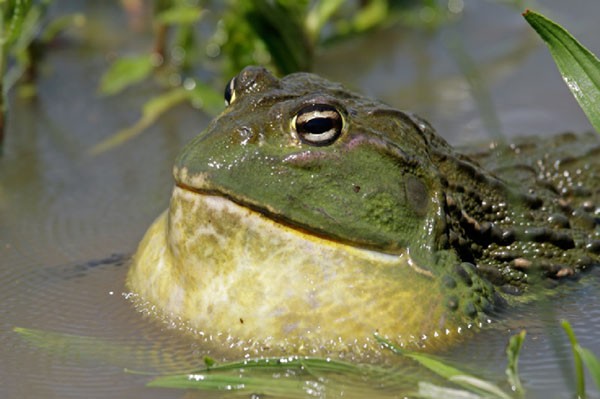Giant African Bullfrog (Pyxicephalus adspersus)
Natural history
The African bullfrog lives in a variety of arid and semiarid habitats in central and southern Africa. This frog has long ridges on the skin of its back and a huge head.
The pet trade is supplied by captive-bred and wild-caught specimens. African bullfrogs are often called “pixie” frogs, derived from their genus, not their size. It is theorized that a number of different subspecies or species are now sold in the trade as African bullfrogs.
Taxonomy
Class: Amphibia
Order: Anura
Family: Ranidae
Bullfrogs, leopard frogs, rice paddy frogs
Color and Size
African bullfrogs are olive green in color. The males have a yellow or orange throat, while female throats are cream-colored. Females may also retain the dorsal yellow stripe seen in the juvenile.
African bullfrogs are large, often weighing more than 2 kg (4.4 lbs). Males may reach 20-25 cm (8-10 in) in length. Females are typically half this size.
Diet
Feed adult bullfrogs insects such as locusts, crickets, cockroaches, mealworms, moths, beetles and waxworms, as well as fish, earthworms, and mice. Bullfrogs may also be fed an occasional mouse. Bullfrogs have a voracious appetite and sometimes jump quite high. Since they can mistake fingers for food, they should be fed with tongs.
Dust invertebrate prey regularly with a vitamin/mineral supplement.
Husbandry
| Temperature | Provide a temperature gradient of 77- 82°F (25-28°C). Do not use a radiant heat source as these tend to dry amphibian environments. |
| Water | Offer a large, shallow water dish, in which the bullfrog will spend much of its time, and lightly mist the enclosure regularly. Between mistings the substrate should remain damp, but not water logged.Potential water sources include: |
- Aged water: Allow chlorinated water to sit in an open container for 24-48 hours so chlorine can dissipate
- Bottled spring water
- Filtered tap water: run through a sediment and activated charcoal filter
Cage size and designAlthough bullfrogs are very large, they are not very active. One adult may be kept in a long, 20-gallon (75 liter) terrarium.Cage furniture/suppliesProvide low-intensity full-spectrum lighting for optimal absorption of dietary calcium. Provide hiding places at each end of the cage (i.e. live or artificial plants). Consider sandy soil as a cage substrate for burrowing. Alternatively, frogs may be housed in a bare tank containing 1-2 in (2.5-5 cm) of water and a styrofoam platform, which can serve as a haul-out region. Frequent cleaning of the tank is necessary because of the prodigious amount of feces bullfrogs can pass.Social structureHouse African bullfrogs separately.
Lifespan
Up to 20 years is common, however African bullfrogs may live 45+ years.
Mature by 1.5-2 years.
Anatomy/ physiology
| Dermatologic: |
|
| Gastrointestinal: | A short, simple gastrointestinal tract empties into a cloaca. |
| Cardiac: | A three-chambered heart is encased within the pectoral girdle. |
| Lymphatics: | All amphibians possess lymph hearts, which beat in synchrony independently of the heart. |
| Miscellaneous: | If temperatures fall below recommended levels, then the African bullfrog may estivate or enter a period of “partial hibernation”.Frogs possess coelomic and inguinal fat bodies. |
| Urogenital: | A renal portal system is present |
| Sexual dimorphism: | Unlike most other species of frog, the male is larger than the female. Females are usually a lot smaller than males with rounder body shape.During the breeding season, male bullfrogs will call. They will also develop nuptial pads on each thumb as well as yellow or orange throats. |
Restraint
Their ridged skin means that the African bullfrog is one of the few amphibians that can be handled, although handling still should not be done too regularly or for prolonged amounts of time. Like all amphibians, bullfrogs possess relatively delicate, absorbent skin so handle the frog with clean, wet hands or with moistened surgical gloves.
Use caution since adult African bullfrogs can inflict a painful bite.
Venipuncture
Ventral midline vein
Preventive medicine
Perform a visual exam by placing the frog in a clear plastic box or tub.
Physical examination prn (as needed).
Important medical conditions
- Foreign body ingestion
- Nutritional secondary hyperparathyroidism or metabolic bone disease (Download the client handout:
Metabolic Bone Disease in Reptiles and Amphibians). - Obesity
**Login to view references**
References and further reading
References
The Amphibian Forum. African bullfrog care sheet. The Amphbian.co.uk. Available at http://www.theamphibian.co.uk/African_Bull_Frog_Pyxie_frog_care_sheet_Pyxicephalus_adspersus.htm. Accessed on February 19, 2011.
Bartlett RD, Bartlett, PB, Griswold B. Reptiles, Amphibians, and Invertebrates: An Identification and Care Guide, 2nd ed. Hauppage, NY: Barron’s Educational Series; 2010.
Gampper T. The natural history and care of the African Bullfrog. Melissa Kaplan’ Herp Care Collection. 2002. Available at http://www.anapsid.org/ornatacare.html. Accessed on February 19, 2011.
Mailloux R, de Vosjoli P. Giant African Bullfrogs: Life History and Captive Husbandry [kindle edition]. 2012.
Wells KD. The Ecology and Behavior of Amphibians. Univ Chicago Press. 2007.
Wright KM, Whitaker BR. Amphibian Medicine and Captive Husbandry. Malabar (Kerala): Krieger; 2001.
Pollock C. Basic information sheet: Giant African bullfrog. July 12, 2012. LafeberVet Web site. Available at https://lafeber.com/vet/basic-information-giant-african-bullfrog/
